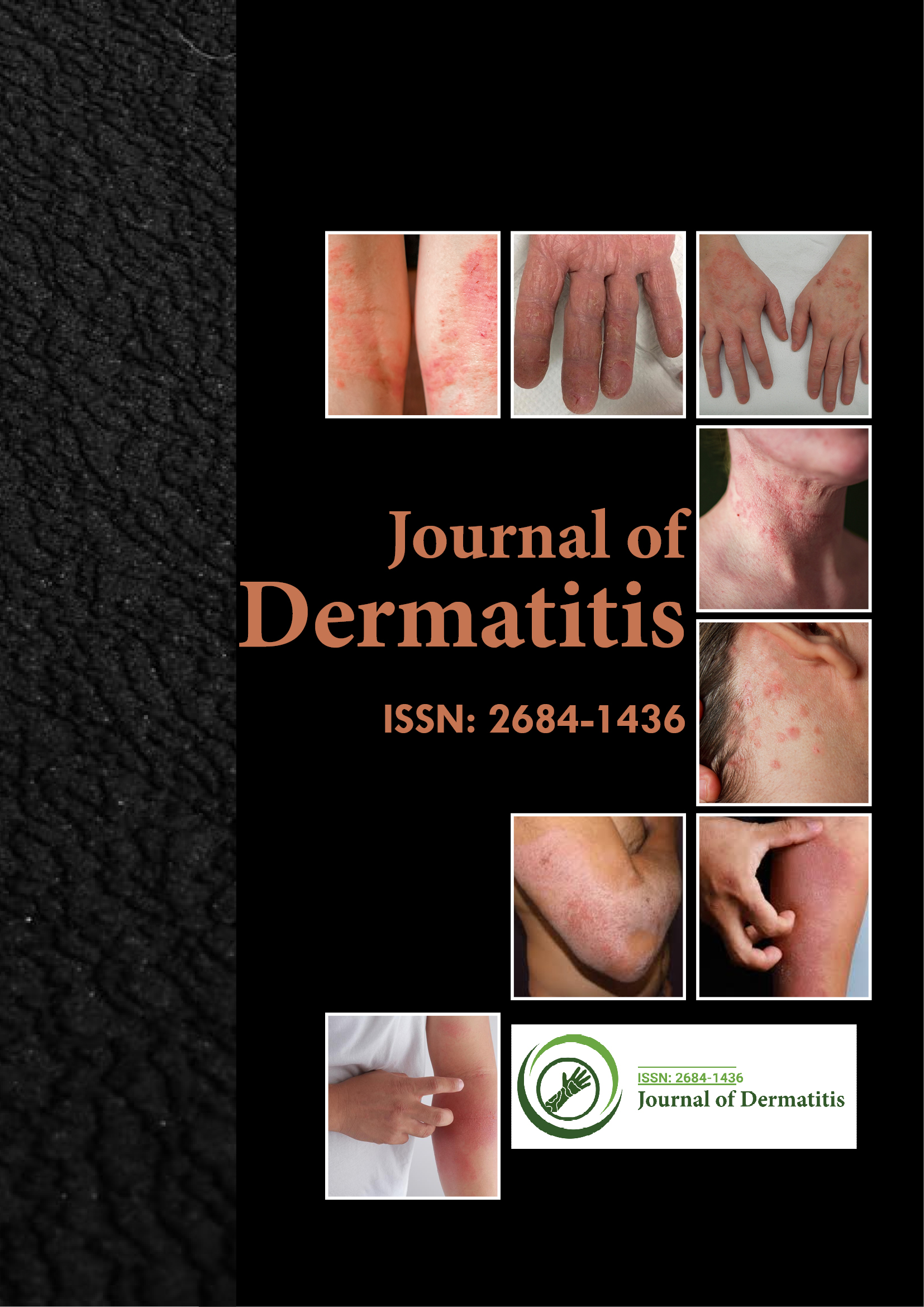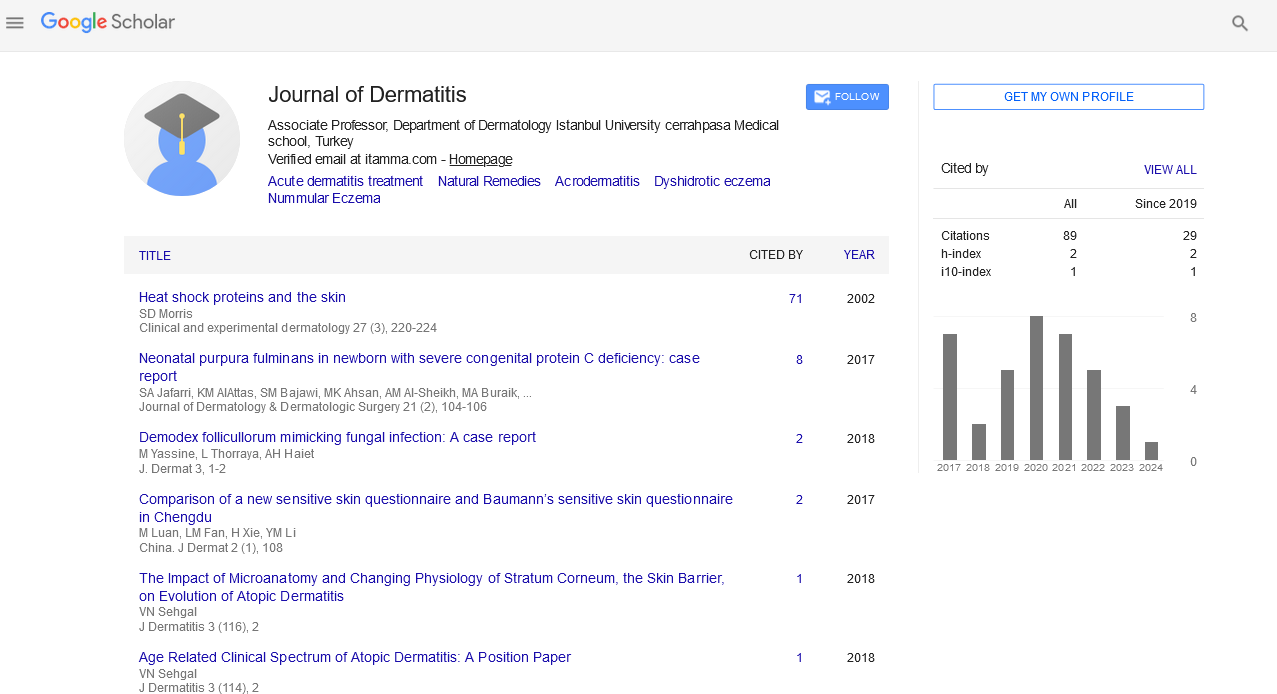Indexed In
- RefSeek
- Hamdard University
- EBSCO A-Z
- Euro Pub
- Google Scholar
Useful Links
Share This Page
Journal Flyer

Open Access Journals
- Agri and Aquaculture
- Biochemistry
- Bioinformatics & Systems Biology
- Business & Management
- Chemistry
- Clinical Sciences
- Engineering
- Food & Nutrition
- General Science
- Genetics & Molecular Biology
- Immunology & Microbiology
- Medical Sciences
- Neuroscience & Psychology
- Nursing & Health Care
- Pharmaceutical Sciences
Commentary - (2022) Volume 7, Issue 6
Protein Contact Dermatitis: An Allergic Skin Reaction
Jason Zirwas*Received: 01-Nov-2022, Manuscript No. JOD-22-19068; Editor assigned: 04-Nov-2022, Pre QC No. JOD-22-19068 (PQ); Reviewed: 18-Nov-2022, QC No. JOD-22-19068; Revised: 25-Nov-2022, Manuscript No. JOD-22-19068 (R); Published: 02-Dec-2022, DOI: 10.35248/2684-1436.22.7.167
Description
A skin allergy brought on by proteins of either animal or plant origin is referred to as Protein Contact Dermatitis (PCD). The specific requirements for protein contact dermatitis include the following: (1) a chronic dermatitis brought on by contact with proteinaceous material; (2) an acute urticarial or vesicular eruption that appears minutes after contact with the offending protein; (3) immediate prick- or scratch-test results that are typically positive; and (4) patch-test results that are frequently negative.
Plant, animal, flour, and proteolytic enzymes are the four types of proteins that can result in protein contact dermatitis. Anecdotally, a history of atopy, persistent irritant dermatitis, and a job or hobby involving exposure to one of these protein allergens are risk factors for the development of protein contact dermatitis.
Avoiding the specific allergen is crucial in the therapy process. Short-term corticosteroids, immunomodulatory drugs, or antihistamines can all be used to relieve symptoms.
Numerous hypotheses have been put forth. The most widely recognised idea is that protein contact dermatitis results from high-molecular-weight proteins penetrating the epidermis and is a type I acute hypersensitivity reaction with superimposed irritating contact dermatitis or allergic contact dermatitis. In fact, this hypothesis is supported by the findings that between 56% and 68% of individuals with protein contact dermatitis have a history of atopy, and that urticaria flare-ups frequently occur after contact with the causal substance.
Others assert that a combination of type I and type IV delayed hypersensitivity reactions could cause protein contact dermatitis. Because big protein-based compounds cannot permeate intact, unaffected skin, negative patch-test results may occur. It's also conceivable that the type I histamine reaction could prevent the type IV response from being detected. Experiments with chronic dermatophytosis, in which Trichophyton mentagrophytes causes an instant type I reaction without a subsequent delayed type IV response, support this. However, a positive delayed type IV reaction is discovered when the antihistamine chlorpheniramine is given, inhibiting the type I reaction.
Finally, a delayed hypersensitivity reaction mediated by Immunoglobulin E (IgE), similar to that hypothesised for atopic dermatitis, may be involved in the pathophysiology of protein contact dermatitis. IgE-bearing Langerhans cells are thought to facilitate systemic growth of TH 2 memory T cells in atopic dermatitis by bringing in interleukin IL-5, IL-4, IL-13, and IL-3. Eosinophilia, a rise in IgE, and the growth of mast cells result from this.
A TH 2-type response with a potent IgE-mediated response was seen in a mouse model of protein contact dermatitis generated by natural rubber latex, along with an increase in CD4+ CD3+ T cells, mast cells, and CD4+ CD3+ T cells. Another protein contact dermatitis experimental paradigm resulted in the development of T cells, eosinophil infiltration, and the production of IL-4 and IL-5.
Compared to cooked food, where proteins are partially denatured, interaction with raw food is more likely to cause responses with many meals. Onions are a famous example of a food that deviates from this norm.
Conclusion
Direct contact with one of the aforementioned allergens is the most frequent cause of protein contact dermatitis. A protein contact dermatitis can, however, also be brought on by systemic exposure to the allergen, such as through ingestion or inhalation. In one study, a systemic response to protein was seen in 3 out of 22 patients with protein contact dermatitis. In a different case study, a housewife with a history of protein contact dermatitis to cabbage experienced a flare-up of the condition after consuming okonomiyaki, a dish made primarily of heatcooked cabbage.
Citation: Zirwas J (2022) Protein Contact Dermatitis: An Allergic Skin Reaction. J Dermatitis. 7:167.
Copyright: © 2022 Zirwas J. This is an open-access article distributed under the terms of the creative commons attribution license which permits unrestricted use, distribution and reproduction in any medium, provided the original author and source are credited.

